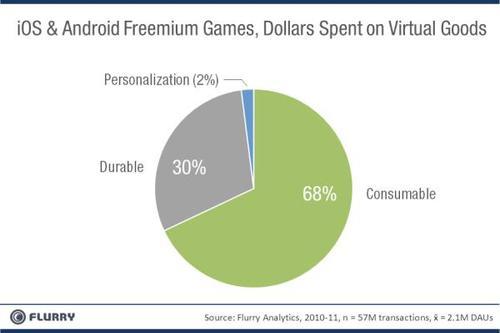Last month, we published two posts about iOS and Android freemium game revenue. The first showed that, over the first half of 2011, game revenue in the App Store shifted dramatically from premium to freemium, with 65% of all revenue generated among the top 100 games now coming freemium games. In fact, at the time of writing this blog post, all of the top 5 titles in the App Store top grossing category were freemium games, and 22 of the top grossing 25 were games. The second post revealed that consumers spend an average of $14 per transaction when making in-app purchases in freemium games.
With in-app purchases in freemium games driving the bulk of revenue generation in the iOS and Android app economy, Flurry devotes this post to what consumers actually spend their real dollars on. With over a year’s worth of data, Flurry categorized over 57 million purchase transactions across a set of freemium iOS and Android games that averaged over 2 million daily active users.
As in the world of retail goods, the two main categories available for purchase in freemium games are durable and consumable goods. In freemium games, we define durable goods as items that provide a permanent gameplay benefit. Examples include buying armor to increase defense in a role-playing game, or buying a building in a city simulation to increase city revenue. By contrast, a consumable item is something that is depleted when used. Examples include a set of grenades in a war game, or fertilizer that helps crops grow faster in a farming simulation. Finally, we define personalization items as those that are durable but do not add any gameplay benefit (i.e., purely decorative).

The chart shows that over two-thirds of all items purchased in iOS and Android freemium games are consumable, goods that users deplete. Measured another way, approximately half of all real dollars spent within all apps are for game items consumers don’t keep. Based on our data, the most popular virtual purchase, consumable or otherwise, is for “premium” in-game currency. Premium currency can be spent in a number of ways to accelerate progression in a given game, including converting it into “grind” currency, the primary currency that consumers accrue and use through normal gameplay (a.k.a. the “grind”). Premium currency, which also allows consumers to purchase special items that cannot typically be acquired with regular “grind” currency, is said to “alleviate the grind” (i.e., allow a user to advance faster in a game). Games that are designed with consumable items in mind tend to monetize very well. For developers, this offers the best ROI on game development resources.
Next, durable items represent 30% of all in-app purchases in freemium games. From a game design standpoint, it’s important to have a good selection of durable items in a game as it offers important variety to the consumer with respect to the core gameplay, such as erecting buildings in a city. Buying increasingly better performing durable items gives players a sense of progress, which can be important for engagement. Additionally, offering bigger, better durable items allows users to set goals, or even change their gameplay strategy, in order to save up for, and make, bigger purchases.
As a side-note, the ratio between consumable and durable should vary depending on how critical these items are to the core gameplay experience. For example, a city-building game could lean more toward durables (e.g., buildings), since user progression is measured by creating a larger city, which is made up of individual buildings. In contrast, a farming game could lean more towards consumables (e.g., seeds and fertilizer), where the game is about growing, harvesting and selling crops in order to earn grind currency.
Finally, personalization items represent only 2% of purchases. Since these items don’t affect gameplay, consumers purchase them infrequently. Also, consumers don’t tend to decorate, and then re-decorate, in most games. For example, think about how often you change your Facebook or Linked In profile picture. The rule should be that if a game is not largely about personalization, then add just enough of these items to allow players to create their own unique gameplay look and feel.
With Flurry estimating that total U.S. iOS and Android game revenue will surpass $1 billion in 2011, game developers should understand what consumers spend the majority of their money on. As a business model, freemium games are here to stay. While the consumer is indeed purchasing virtual items that are most often consumable, what’s most important to understand is the psychology behind these games. In freemium games, consumers are experiencing compelling, immersive entertainment. They feel gratified when they progress, accomplish goals, create a unique world, and in some cases, show off to their friends. In exchange for this gratification, they are willing to spend real money, and lots of it.